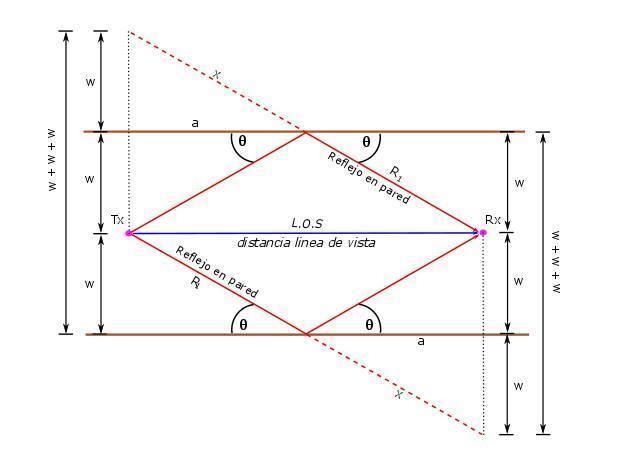 | ||
In the theory of antennas, the six rays model is the mathematical approach performed from of the geometry in the first three rays that describe the loss between a transmitting antenna receiver, generally the receiver antenna has a height equal or different relative to the transmitter and each ray contain your respective reflection, the three rays direct are observed since a perspective top and the reflected are observed since a side of the antennas because these are below of the rays direct. The first two direct rays have two reflections were each one hit with each building that separate the street or SW (single wall reflected) and the other is a ray that go direct to the receiver known as LOS (Line of sight).
Contents
- Analysis for antennas of heights equal located in the center of the street
- Analysis for antennas of heights equal located in any point of the street
- Analysis for antennas of heights different located in the center of the street
- Analysis for antennas of heights different located in any point of the street
- Losses for trajectory on free space
- References
Analysis for antennas of heights equal located in the center of the street
Considering that the height has no variation in the antennas then
To be located in the center of the street the distance between the antennas
The mathematical model of propagation of six rays is based in the model of two rays, for find the equation of each ray involved. The distance
For the ray reflected for below of this
For
For
For
Analysis for antennas of heights equal located in any point of the street
Due that the direct ray LOS has no changes and doesn't present angular variation between the rays, the distance of the two first rays
For similarities of triangles in the top view the model it determined the equation of
For
Analysis for antennas of heights different located in the center of the street
For antennas of different heights with rays that rebound in the wall, observed that the wall is the half point, where the two transmitted rays they fall on such wall. This wall has half the height between the height of the
Analysis for antennas of heights different located in any point of the street
For the mathematical six rays model of propagation for antennas of different heighs located in any point of the street, is based on the model of the two rays to find the equations of each ray involved in this model, each antenna has a different height, then
The second ray or the reflected ray does similar to the first ray but adds the heights of the antennas to form the right triangle for the reflection of the heigh of the transmitter :
For deducing the third ray it is found that angle between the direct distance
Now deducing the height that subtraction of the wall with respect the height of the receiver called
By similarity of triangles it can be deduced the distance where the ray hits the wall until the perpendicular of the receiver called a achieved:
By similarity of the triangles can be deduced the equation of the fourth ray, observing:
For
Losses for trajectory on free space
Considering a transmitted signal through of the free space to a receiver located at a distance d of the transmitter.Assuming that there is no obstacle between the transmitter and the receiver, the signal it spreads along of a straight line between the two. The model of ray associated with this transmission is called line of sight (LOS), and the signal receives corresponding is called signal of LOS
The loss of trajectory on free space of the model of six ray in the space free is defined as:
